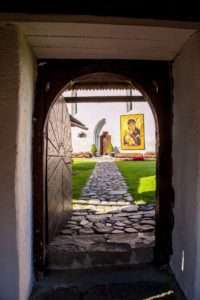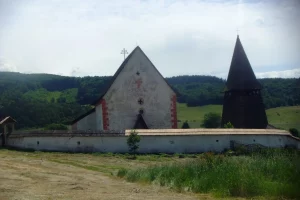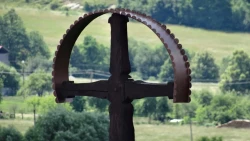Cserény

Cserény (in Slovak: Čerín) is a village in Besztercebánya district, Banská Bystrica county, Slovakia. It belongs to Csécsény, and it is only 14 kilometers from Besztercebánya (Banská Bystrica).

The church of Cserény (Čerín) is hidden in the foothills of the Polyána Mountains in the former Zólyom county. The church stands on a hill above the village and can be seen from afar with its wooden bell tower and stone surrounding walls. However, the true value of the church is only revealed once you enter. Although the village of Cserény, with its 445 inhabitants, is not one of the most visited by tourists, this church proves that, besides the nearby towns of Zólyom and Besztercebánya, the historical monuments hidden in the valley are worth a visit.

Cserény was first mentioned in 1153 and was part of Zólyom County. In the age of the Árpád Dynasty, King András III gave Villa Cheren to Comes Pál, the son of Madách of Kürtös, who was the servant of Comes Demeter of Zólyom County (the ancestor of Madách Imre), in exchange for his military merits. The church was built in the first thirty years of the 14th century.

However, Zolnay László, who studied the church, dated it to 1315 without giving any reasons. This was later taken over by the village tradition. In 1351 it is mentioned in the sources as the property of the Madách family, when it had to be divided among the sons of the deceased Pál, and at the same time the boundaries of the village were surveyed. In 1375 King Lajos gave it to Balog in Hont County to Pál’s son, Master Lökös and his sons in exchange for the Cserény estate. It was probably at this time that it became part of the Végles estate, which appears as a royal estate in 1424.

In that year, King Zsigmond gave Zólyom County and its possessions, including the Végles manor and Cserény, to his wife, Borbála. From then on the estate was in royal hands. It is still mentioned as a royal estate in the 16th century. Although the area did not come under Turkish rule, the Turks burned and taxed the village in 1578, so the stone wall around the church probably dates from that time.

The history of Cserény in the 17th century is not fully known. It is certain that in 1693 and 1695 it was mentioned as the property of the Beniczky family. However, it is questionable when the Beniczky family became the owners of the area. According to a record from 1603, the poet Beniczky Péter received estates in Upper Hungary for his military merits. This may be connected with the private ownership of the village.

The church has a single-nave, straight-ended sanctuary, with a sacristy attached to the north side. Entrances to the church are on the west and south sides. There is no tower attached to the building, and a 17th-century wooden belfry was built to the south of the church. There is a painted wooden chancel at the west end, added in the 18th century.

Entering through the west door reveals a beautiful medieval church with frescoed walls and a painted wing altar in the sanctuary. Art historians have been interested in the value of this tiny church since the last century. In the 1920s and 1930s, Peter Kern restored the church’s murals, but his additions and paintings were later removed.

Zuza Bartošová examined the frescoes during the restoration work carried out by Balassa Géza in the 1970s, and Zolnay László, one of the archaeologists who excavated the Buda Castle, examined the church in 1979. This may also have been the time of the small archaeological excavations that uncovered tombs in the sanctuary. The frescoes in the sanctuary are the best preserved.

The north side of the sanctuary is decorated with the scene of the Last Judgement, which art historians date to the end of the 14th century. On the east wall, on either side of the ogival window, are painted scenes of the Crucifixion and the Lamentation of Jesus. Unfortunately, the south side is not in such good condition, as the church was bombed during the Second World War, and the southern part of the sanctuary was the most damaged.

The sanctuary and sacristy are covered by a transept with six-petalled rosettes on the keystones. The most beautiful fresco in the vault of the sanctuary is the Maiestas Dominia, depicting the glorious Christ with his feet on the hemisphere representing the universe, surrounded by the Apostles.

The triumphal arch and the walls of the nave were also frescoed, but unfortunately, only a fragment remains. To the north is the figure of St George with the Dragon, considered the “youngest” mural in the church, dating from the 1420s. It is also the site of the image of Mary in the Gown.

On the southern side, Saint László is shown defeating the Cuman warrior. Next to the figure of St. László, there is a figure resembling a page, who is considered to be the patron of the fresco, and as the painting is dated between 1370 and 1380 when the village passed into royal hands, Zolnay László believes that the patron was probably King Louis the Great. Two of the twelve consecration crosses remain in the nave, of which the one on the south side is in a 14th-century state.

The nave was covered with a wooden roof in the 16th century. The Renaissance columns, one of which is decorated with geometric paintings, were added at the same time. On the north side of the eastern end wall of the sanctuary, there is a simple medieval pastorium, a sacristy niche with a preserved door with iron bars. A special feature is the stone-carved baptismal font, dating from around 1300.

The outer walls of the church are plastered white, with paintings in the corners. In his description of the church, Zolnay László mentions that on the southern façade there is a picture of a crown and on the eastern wall there is a large figure of St Christopher, the patron saint of pilgrims, but these external wall paintings were still in a very bad state in 1979 and have now been completely destroyed.

Cserény not only has frescoes but also a beautiful medieval altar, which was moved to the Church of the Assumption of the Virgin Mary in Buda at the end of the 19th century and is now on display in the Hungarian National Gallery. According to an inscription, the altar was donated to the church in 1483 by Petrovits György.

The altar depicts the life of Saint Martin, the patron saint of the church. The figure of the saint is in the center, with St John and probably St Bereck (St Martin’s deacon) on either side. The fold-out panels depict events in the life of Saint Martin. Today a replica of this altar can be seen in Cserény.

The only difference between the original and the copy is that the replica shows the Virgin Mary with the Child Jesus in the center, with St. Martin and St. John on either side, while the figure of St. Bereck has disappeared from the altar. The medieval church of Cserény is fascinating not only because of its relics from the past but also because of the small, vibrant congregation led by the local parish priest, Dušan Mesíktart.

In addition to his parochial duties, he also cares about the preservation of the church, and this year he took the initiative of making a copy of the altar and began restoring the frescoes in the sanctuary. The church, enlivened by the bouquets he has prepared, is always open to visitors, keeping alive this 700-year-old common heritage.

Source: Rakonczay Rita https://www.academia.edu/38273754/A_cser%C3%A9nyi_Szent_M%C3%A1rton_templom
Dear Readers, I can only make this content available through small donations or by selling my books or T-shirts:
Please, feel free to support me with a coffee here:
You can check out my books "33 Castles, Battles, Legends" and "The Ring of Kékkő Castle" on Amazon or Draft2Digital, they are available in hardcover, paperback, or ebook: https://www.amazon.com/dp/198020490X or at https://books2read.com/b/boYd81
 My work can also be followed and supported on Patreon: Become a Patron!http://Become a Patron!
My work can also be followed and supported on Patreon: Become a Patron!http://Become a Patron!


https://hungarianottomanwars.myspreadshop.com/all
Here are more pictures of Cserény:






























